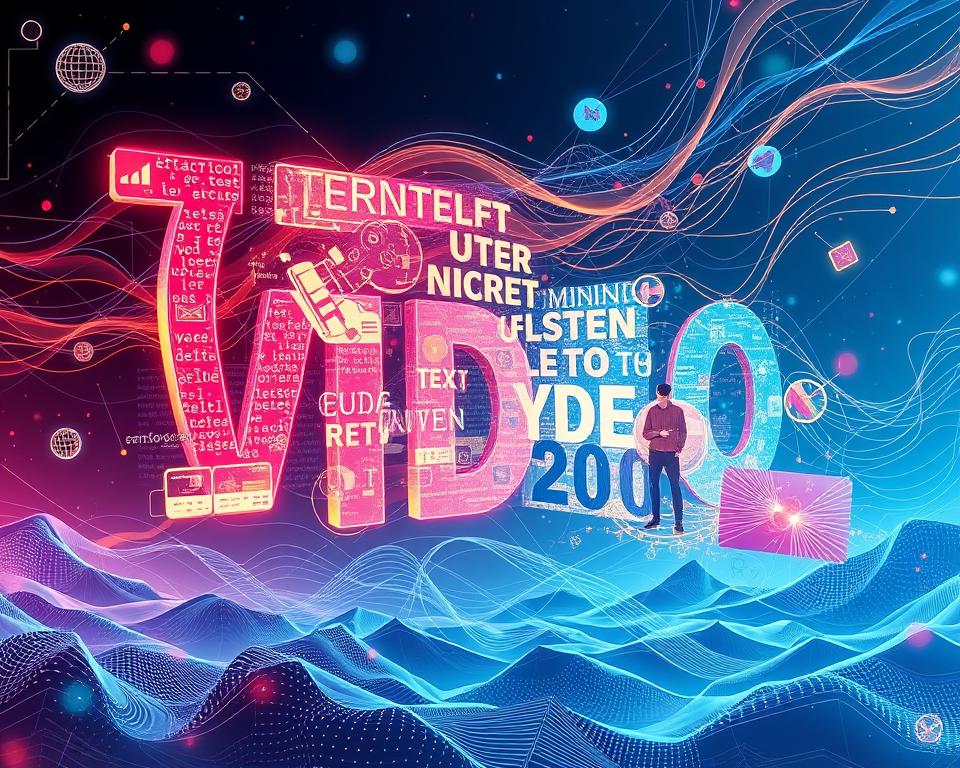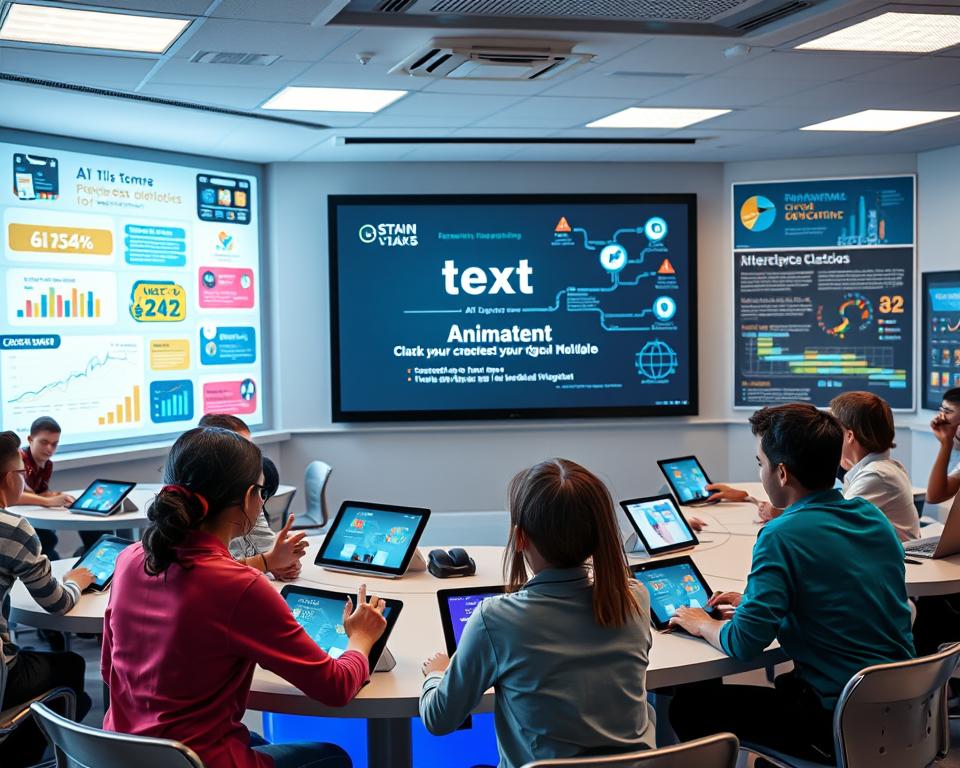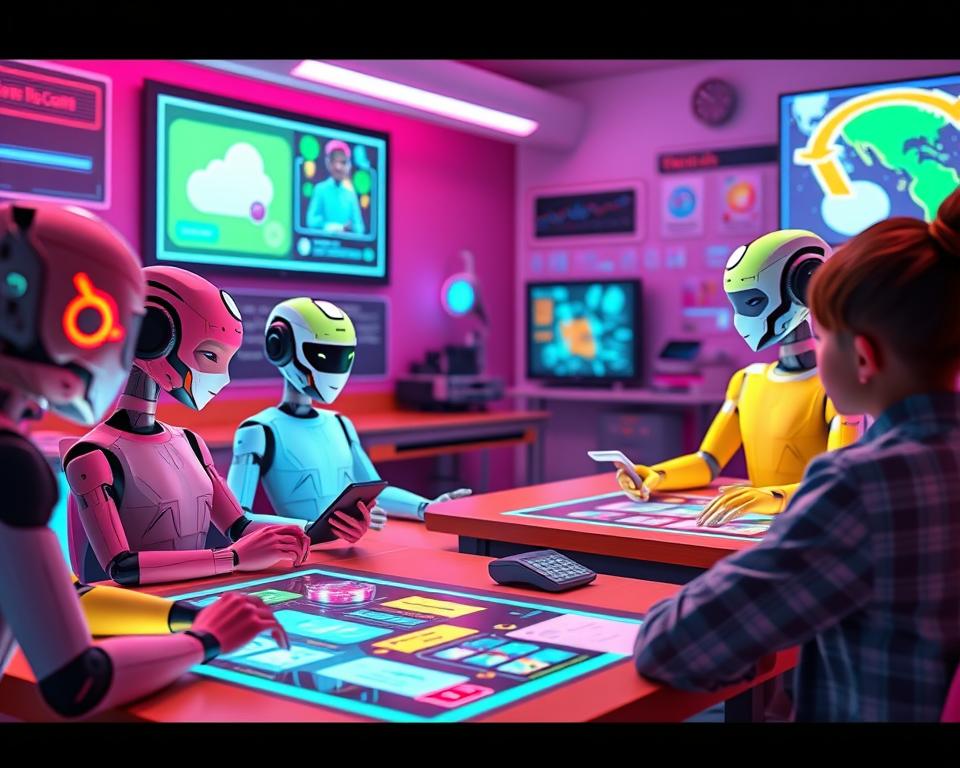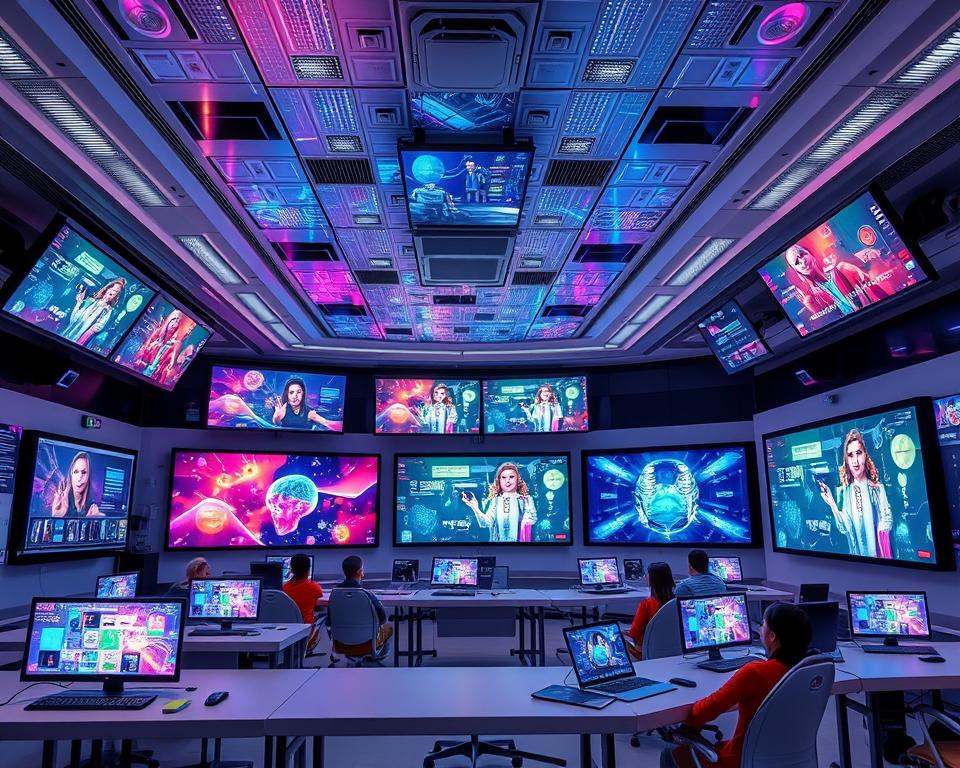In this article, we’ll explore the Best AI Text to Video for E-Learning Content and how it’s changing the way we teach online. These amazing tools make it super easy to create videos that students love to watch – no tech skills needed! You can turn your regular text into engaging videos with cool voices and characters that make learning fun.
This guide shows how top AI tools can make learning fun and personal. It helps teachers make better, more engaging lessons for their students.
Key Takeaways
- AI tools can turn text into great videos for online learning – fast and simple.
- These tools use smart tech to make videos with computer voices and characters from regular text.
- Making videos with AI saves time and money, plus students pay more attention and remember better.
- Teachers can customize lessons, make quick changes, and work together easily with this tech.
- Anyone can make good videos in minutes – no video editing skills or big budgets needed.
Understanding AI Text-to-Video Technology in Education
AI technology has changed how we make and use learning materials. AI text-to-video conversion is a big step forward. It turns written text into ai-powered educational videos easily.
How AI Text-to-Video Conversion Works
The AI system starts by understanding the text. It uses special algorithms to get the text’s meaning and feel. Then, it picks the right voice and visuals for the video.
It makes the video with audio, animations, and interactive learning content.
Core Components of AI Video Generation
- Voice Selection: The AI picks a voice that sounds like a real person.
- Text Input: The text is given to the AI, which makes the video.
- Customization Options: You can change things like music, subtitles, and style.
Natural Language Processing in Video Creation
NLP is key in AI text-to-video tech. It understands the text’s meaning and context. This lets the AI make videos that are both fun and useful.
AI text-to-video is set to change education. It will make learning materials better and more accessible for everyone.

Top Benefits of AI Video Tools for Educational Content
The world of education is changing fast. AI video tools are making a big difference in how students learn. They help with better engagement, keeping students interested and learning more.
AI text to video tools make learning fun and engaging. They use video storytelling for education to grab students’ attention. This way, students remember what they learn better than with just text.
These tools also make learning personal and flexible. They adjust to how each student learns best. This means students learn in a way that feels right for them.
AI video tools also help teachers save time. They make creating educational videos easier. This lets teachers focus on teaching and talking to students, not just making videos.
AI video tools are changing online learning too. They make videos that are fun and interactive. Students can learn from anywhere, making education more accessible.
In short, AI video tools are a big step forward in education. They make learning better, more personal, and fun. As online learning grows, these tools will be key in shaping education’s future.
Best AI Text to Video for E-Learning Content
In the world of e-learning, AI text to video conversion tools are changing the game. They help educators make content that grabs attention and makes a big impact. Three top platforms stand out: Lovo, FlexClip, and Videate.
Synthesia: Professional Training Videos
Synthesia makes creating top-notch training videos easy. It has over 230 AI avatars and supports 140 languages. This means educators can make videos for people all over the world. The Starter plan gives 10 minutes of video a month, which is great for those just starting out.
FlexClip: Social Learning Content
FlexClip is perfect for making short, fun videos for YouTube, Instagram, and TikTok. It’s easy to use and lets you customize videos a lot. This makes it great for creating content that grabs the attention of today’s learners.
Videate: Screen Recording Solutions
Videate speeds up making videos by using AI. It can make videos up to 10 times faster than doing it by hand. This is great for recording software tutorials and other screen-based content.
These AI text to video platforms help with different types of e-learning content. They make creating videos faster, better, and more engaging. This helps educators do their jobs more efficiently and reach their students in new ways.

“AI-powered video creation tools are revolutionizing the e-learning industry, enabling educators to produce high-quality, multilingual content at unprecedented speed and scale.”
Best AI Text to Video for E-Learning Content: Features Comparison
Choosing the right AI text-to-video platform is key for engaging educational videos. As video storytelling in education grows, it’s vital to compare AI video tools. This guide will help you pick the best for your e-learning needs.
Look at the avatar library size and language support. Synthesia has 230+ avatars and 140+ languages, great for diverse content. Colossyan lets you import PowerPoint slides, making it easy for e-learning pros.
Hour One offers realistic avatars with customizable gestures. This is perfect for making educational videos more engaging.
Consider rendering speed, video templates, and editing ease. These affect your content’s quality and efficiency.
“AI text-to-video tools provide a more personalized learning experience based on individual learners’ needs and preferences.”
Also, check for integration with learning systems, SCORM compliance, and analytics. These help track your video’s performance. By comparing these features, you’ll find the ideal AI text-to-video solution for your e-learning content.
Maximizing Video Production with AI Voice Technology
The need for engaging multimedia learning resources is growing fast. AI voice technology is changing the e-learning world. It makes video production easier and improves the quality and reach of educational content.
Voice Cloning and Synthesis Options
AI tools like Eleven Labs and HeyGen AI can create realistic voiceovers. They offer many voice options. This makes it easy to support many languages and keep voices consistent.
Multilingual Support and Localization
AI voice tech is great for supporting many languages. Synthesia, for example, can use over 140 languages. This helps reach a global audience and makes learning more accessible.
Audio Quality and Natural Speech Patterns
AI has improved audio quality and speech patterns a lot. Tools like Veed.io remove background noise. This makes learning more enjoyable. Also, typing can create new audio content, saving a lot of time.
“The rise of remote work led to the emergence of a video-first training approach, and AI-powered tools have made it possible for individuals with little to no technical knowledge to create professional-grade videos easily.”
AI video tools and text-to-video conversion are getting better. AI voice tech is key to making e-learning more effective and accessible. It helps creators make engaging, multilingual, and high-quality videos for all learners.
Creating Engaging Educational Content with AI Avatars
In e-learning, AI avatars have changed how we make and share interactive learning content. These virtual helpers add a personal touch and make learning fun. They help learners dive into immersive learning experiences in virtual classrooms.
Tools like Synthesia and Elai let you customize AI avatars. They can look and act like real people. This makes learning more interesting. They can also teach in many languages, helping learners from all over.
- Synthesia’s AI video maker has 230+ AI avatars and voices in over 140 languages. It works well with Learning Management Systems.
- Elai, used by over 2000 companies worldwide, has 80+ high-quality avatars. It can clone voices in 28 languages and supports 75+ languages and 450+ accents.
AI avatars help teachers make scenario-based learning, simulations, and interactive tutorials. This makes learning more fun and helps learners remember more. AI makes making videos faster and cheaper, keeping the quality high.
“Synthesia’s AI video generator has been a game-changer for our global training team, allowing us to reduce video and voiceover costs by over 50% compared to hiring voiceover artists in multiple languages.” – Xerox Global Training Team
As e-learning grows, AI avatars will make learning more personal and fun. They promise to bring immersive learning experiences to virtual classrooms. With AI, teachers can make learning spaces that are dynamic, interactive, and easy to reach for all learners.

Integration and Compatibility with Learning Management Systems
Seamless integration with Learning Management Systems (LMS) is key for a great e-learning experience. When picking the best AI text-to-video tools, look at their LMS compatibility and integration.
SCORM Compliance and Export Options
SCORM (Shareable Content Object Reference Model) is important. It lets your AI videos work well in many LMS places. Choose tools that support SCORM export for easy LMS integration.
API Integration Capabilities
Good API integration makes workflow smooth between your AI tools and LMS. It helps with data sharing, content updates, and user management. This boosts your e-learning system’s efficiency.
Platform Compatibility Standards
Before choosing an AI video tool, check if it works with your learning platform. Make sure it connects well with common platforms like Moodle, Blackboard, Canvas, and Brightspace. This way, your students get a smooth, hassle-free learning experience.
Focus on LMS integration and compatibility to get the most from AI in e-learning video production, ai-powered educational videos, and virtual classrooms. This creates a cohesive and engaging learning space for your students.
Conclusion
The best AI text to video for e-learning content has transformed the way we teach online. Think about it – we’re creating videos that truly engage students, and the technology keeps improving. Soon we’ll see even more realistic avatars and more natural chat interactions.
While AI video creation tools and multimedia learning resources offer great opportunities, we need to use them thoughtfully. It’s not about creating flashy content – it’s about helping students understand and retain information better. Every video should have a clear learning purpose.
The landscape of online learning is evolving rapidly, and AI is at the forefront. By using best AI text to video for e-learning content and AI video creation tools effectively, we’re making quality education more accessible to every student. The future of teaching is here, and it’s full of possibilities.
Ready to make your lessons more engaging?
FAQ’s about Best AI Text to Video for E-Learning Content
What are AI text-to-video tools and how do they revolutionize e-learning content creation?
AI text-to-video tools turn text into videos with AI voices and avatars. They save time and improve learning. They make learning personal, easy to update, and help teams work together.
How does the process of AI text-to-video conversion work?
First, you pick a voice and type in the text. Then, you set up the video. The tool uses AI to make the video, including voice, text, and settings like music and subtitles.
What are the key benefits of using AI video tools for e-learning?
AI video tools boost learning by making it more engaging and easy to remember. They offer personalized learning, make content easy to update, and help teams work together. They also make content accessible to everyone.
What are some leading AI text-to-video platforms for e-learning content creation?
Synthesia has many video templates and supports 140+ languages. FlexClip is great for short videos. Videate makes screen recording fast.
What features should I consider when comparing AI text-to-video tools for e-learning?
Look at the number of avatars, language support, and if you can create your own. Check for gestures, video templates, and collaboration tools. Also, see if they support SCORM export, have analytics, and integrate with other platforms.
How can AI voice technology enhance e-learning video production?
AI voice technology makes voices sound natural and can speak in many languages. Tools like Eleven Labs and HeyGen AI offer different voices and accents. They also keep the original voice’s feel.
How do AI avatars enhance the e-learning experience?
AI avatars make learning feel more personal and interactive. They can show emotions and gestures. Tools like Synthesia and Hour One let you customize avatars for different languages, improving learning.
Why is integration with Learning Management Systems (LMS) important for AI text-to-video tools?
Being SCORM compliant and having API integration is key. It makes learning smooth and lets tools work well with LMS platforms. This makes data exchange easy.
Source Links
- https://vocal.media/education/the-leading-ai-video-creation-platforms-of-2024-a-comprehensive-guide
- https://www.teachfloor.com/blog/best-ai-video-generator-for-education
- https://www.linkedin.com/pulse/text-to-video-ai-revolutionizing-dynamic-content-creation-vasu-rao-26qkc
- https://workmind.ai/blog/prompt-to-video-ai/
- https://simpleshow.com/blog/ai-videos-elearning/
- https://www.colossyan.com/posts/ai-video-generation-in-e-learning
